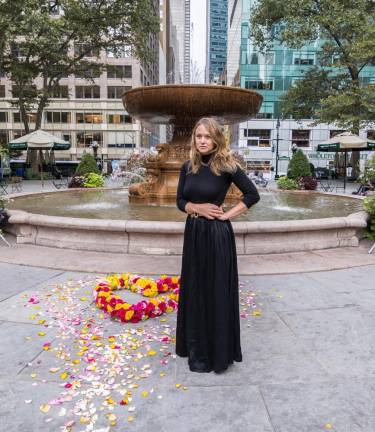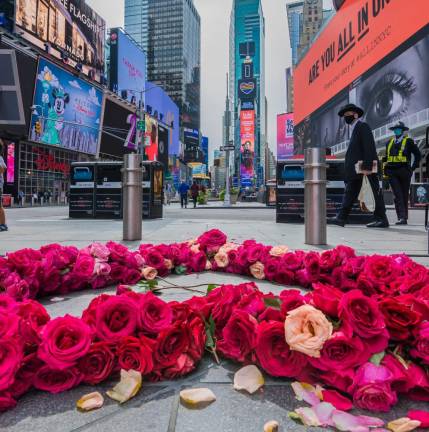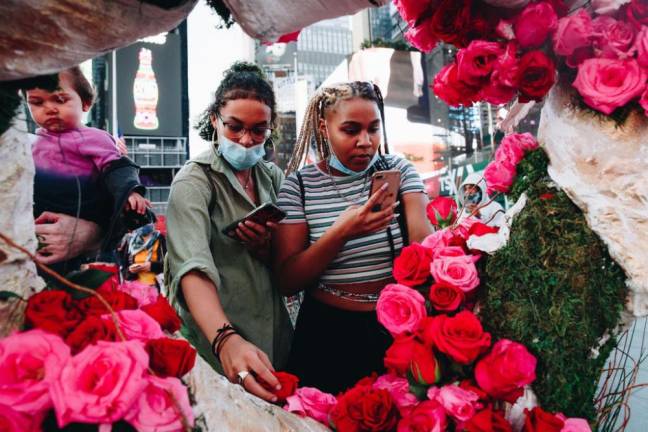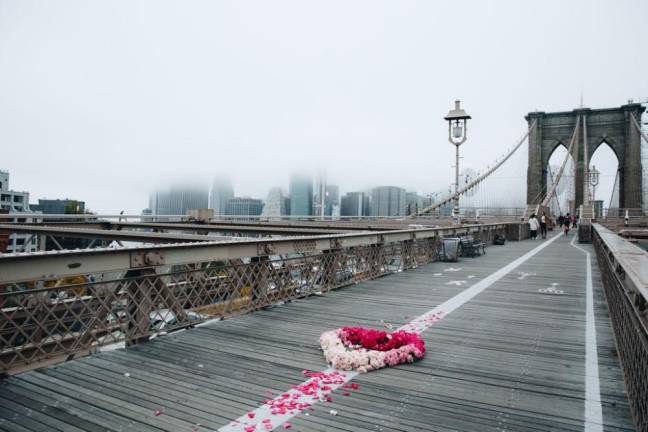Allowing Grief to Blossom
During the pandemic, floral hearts are sprouting up throughout the city, serving a special purpose




While earning her master’s degree, Kristina Libby had studied incidents of mass trauma and how they impacted communities. She noted that for devastating events such as 9/11, New York mourned together in tangible ways, with funerals and the displaying of flowers, photos and letters.
As New Yorkers passed away from COVID, Libby saw that no one was properly grieving their deaths, and knew that this would have future mental health implications for the survivors. That’s when she decided to take matters into her own hands — literally — and be the change she wanted to see in the city. “We saw all of these people dying and there were no visual representations of them. I thought, ‘If no one else is going to do something, I’m going to make something.’”
A florist in her early 20s, Libby, a native of Maine and now a Greenwich Village resident, used her botanical expertise to launch the Floral Heart Project, which she did anonymously at the start. After she placed her first heart — into the East River at Brooklyn Bridge Park — and saw the outpouring of responses, she knew she was not alone in her mission. After a serendipitous meeting with an executive from 1-800-FLOWERS, her initiative grew, and now, at her beautifully crafted creations, gatherers are known to weep or pray after they realize the intent behind them. “I wanted something that would be really easy to understand and hearts, for me, were obvious signs of love, support and hope for the community,” she said.
How did the idea for the Floral Heart Project come about? I read that you were always interested in art, but also suffered a brain injury.
Last August, I suffered a traumatic brain injury while kite-surfing. I fell 12 feet and hit my head on a sand dune at Plumb Beach near the Rockaways. That was physically really crippling and resulted in an extreme amount of headaches and sensitivity to light, which led me back to art. I started painting four to six hours every day as a means of coping with the headaches, because when I would paint, I would have fewer headaches, which was a godsend. And I had been a florist in my early 20s, so knew a lot about flowers and how to work with them, and they’re really a traditional sympathy gift.
What can you tell us about grief from your research?
My master’s degree is in international security and I studied genocide and incidents of mass trauma. And I knew that the pandemic is a mass trauma incident that would deeply impact our community and I spent a lot of time reading and researching and I was worried about America ...You think about 9/11 and school shootings, there are photos, flowers, notes, beautiful funerals. I knew that if we didn’t do something to mark those we had lost, we were going to be a lot worse off. There is a lot of research around this idea called disenfranchised grief. When we push the grief down inside of us and don’t express it, it metastasizes, so when we come out of this trauma moment, the result is that that grief becomes a form of PTSD. And people have more severe depression and anxiety, and a proclivity towards physical violence and substance abuse. And I think it will massively overwhelm our mental health system when we get out of this moment of trauma.
How did your partnership with 1-800-Flowers.com form?
I made 10 or 12 of these on my own and they would cost me $500 to $600 because they would have 300 to 400 flower stems. So I thought, “I need some help.” I happened to be on a Zoom call with a group of people I know and the CMO of 1-800-Flowers.com happened to also be on and asked a question. I asked the man who coordinated the Zoom — his name is Jon Levy and he runs a community called Influencers — to connect me. So I reached out and Amit Shah from 1-800-Flowers.com was incredibly supportive. We started working together in August and they were like, “Let’s do five of these around the city, but let’s do high-profile places. And you have to put your name on it.” Because I had been doing it anonymously; I was so nervous to put my name on. And we did one in Times Square first and that really took off because Times Square is so iconic. Even in the pandemic, when there’s 10 percent of the people there, it still has that thrumming vibrancy of New York City. I think people really responded to that visually and then we moved out to Bryant Park, which I love, and then Macy’s in Herald Square. And we just did one in Rockaway Beach.
Explain your efforts in helping people say goodbye to their loved ones with the tech project you assisted in founding.
COVID Tech Connect was an effort to bring tablets into hospice, senior care facilities and ICU units around America. I’m on a listserve with a bunch of other women, and someone reached out and was like, “We need some tablet computers to put into ICU units.” I used to work at Microsoft, so thought, “Maybe I could help find a couple.” And within four days, me and these other women got together and said, “We’re not just going to get 10 tablets, we’re going to get tablets for the hospice units in every hospital in America.” And we really started up this effort to help people say goodbye to their loved ones and now at the end of 2020, the organization has raised $4 million dollars and is providing 20,000 tablets all around the U.S. It was a total honor to be part of that effort.
Tell us some stories you learned about those who have passed away.
One woman I know, Emmylou, her mom and dad both went into ICU within a week of each other. Both of her parents didn’t even know that the other was also in ICU and dying. And she didn’t get to see either of them. Fiana Tulip, who lives in Brooklyn, lost her mom, who was a nurse in Texas working with COVID patients. She tested positive and died one week later. There was a young girl, we told her story at a vigil, who was 14 years old and healthy, who passed from COVID. There was one woman whose brother was in his 50s and learning disabled and they moved him from a facility to a nursing home so he could have more care, and he contracted COVID in the nursing home. And they couldn’t visit him, so they’d talk on the phone and he kept asking if it was his fault, if he had done something wrong.
There was a family in New York who lost their dad to COVID and the story they tell about him was he had been working his whole life and was supposed to retire early in six months at 55 and travel all around the world. I did one floral heart for a man who committed suicide. He lived in China for 10 years, came back to New Jersey because he wasn’t allowed in China, and felt like he would never be able to go back and there wasn’t more life for him, so he took his life.
To learn more, visit www.floralheartproject.com
Follow Kristina Libby on Instagram @lightvslight